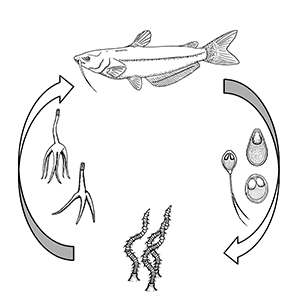This 8-page publication written by Justin Stilwell and Roy P. E. Yanong and published by the Program in Fisheries and Aquatic Sciences of the School of Forest Resources and Conservation discusses myxozoans (multi-celled parasites of marine and freshwater invertebrates and fishes). It provides examples of myxozoans that infect aquarium and warmwater fish; describes them and shows their sizes, shapes, and structures; explains their life cycles and how they are transmitted; presents some methods for diagnosing infections in fish; and gives advice for treatment, prevention, and control of myxozoan infections.
http://edis.ifas.ufl.edu/fa201
Tag: Fisheries and Aquatic Sciences
Spironucleus Infestations (Spironucleosis) in Freshwater Aquarium Fish
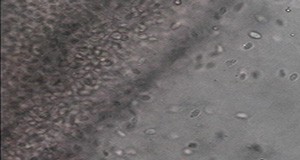
A group of species of single-celled parasites called Spironucleus cause disease in aquacultured and captive fish. Found in cold, temperate, and tropical climates, Spironucleus species can infect a variety of freshwater and marine ornamental and food fish, as well as crustaceans and shellfish.
Five species of Spironucleus are currently recognized: S. salmonicida, S. barkhaus, and S. torosa can infest marine organisms, while S. salmonis and S. vortens can infest freshwater ornamental fish. This four-page fact sheet written by Ruth Francis-Floyd and Roy P. E. Yanong and published by the Department of Large Animal Clinical Sciences focuses on S. vortens and its effects on ornamental cichlids, explaining which cichlids are susceptible, how to identify S. vortens , and how to confirm, manage, and prevent S. vortens infestations. (Photo credit: Roy P. E. Yanong, UF/IFAS Extension Tropical Aquaculture Laboratory)
http://edis.ifas.ufl.edu/vm053
Carp Edema Virus Disease (CEVD) / Koi Sleepy Disease (KSD)
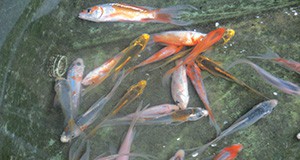
Carp edema virus disease is killing wild and cultured varieties of carp and worrying koi enthusiasts and carp aquaculturists in the United States and around the world. The disease causes skin lesions and swelling and is sometimes called “koi sleepy disease” because infected fish become lethargic and unresponsive. This 5-page fact sheet describes symptoms, diagnosis, prevention, and what fish producers, wholesalers, or retailers can do if they suspect carp may have contracted the disease. Written by Shohreh Hesami, Pedro Viadanna, Natalie Steckler. Staci Spears, Patrick Thompson, Karen Kelley, Roy Yanong, Ruth Francis-Floyd, Johnny Shelley, Joseph Groff, Andy Goodwin, Olga Haenen, and Thomas Waltzek, and published by the School of Forest Resources and Conservation Program in Fisheries and Aquatic Sciences.
http://edis.ifas.ufl.edu/fa189
Using Airlifts to Collect and Concentrate Copepod Nauplii
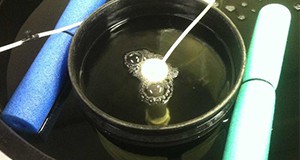
Airlifts are simple and inexpensive and not new to aquaculture. The buoyancy of rising bubbles within a pipe or tube generates an upward flow of water that are often used as part of water treatment design in recirculating aquaculture systems, but can also be used to collect and concentrate live food organisms fed to marine fish larvae. Airlifts are more gentle and efficient than sieving. This 3-page fact sheet provides protocols and designs for harvesting and feeding copepod nauplii to marine fish larvae, but these methods can be adapted for use with many live feed organisms. Written by Eric Cassiano, Matthew DiMaggio, Cortney Ohs, and John Marcellus, and published by the UF Department of Fisheries and Aquatic Sciences, May 2015. (Photo credit: Jason S. Broach)
http://edis.ifas.ufl.edu/fa188
Candidate Species for Marine Ornamental Aquaculture: Porkfish, Anisotremis virginicus
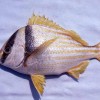 The porkfish is a member of the grunt family, which create a characteristic “grunting” sound by rubbing their pharyngeal teeth together during periods of agitation or courtship. Many species of grunts are popular in public aquariums because they’re abundantly available, and their schooling behavior and bright colors create interest in aquarium exhibits. Porkfish also have additional appeal to aquarists because they are “cleaner” fish during their juvenile phase, picking parasites from larger fish and other vertebrates. Scientists and aquarists have recently achieved a greater understanding of appropriate aquaculture protocols for grunts in general and porkfish in particular. These characteristics and advancements have led to porkfish being identified as a candidate species for commercial aquaculture. This 5-page fact sheet was written by Eric Cassiano and Kevin Barden, and published by the UF Department of Fisheries and Aquatic Sciences, October 2014. (Photo by George H. Burgess, Florida Museum of Natural History)
The porkfish is a member of the grunt family, which create a characteristic “grunting” sound by rubbing their pharyngeal teeth together during periods of agitation or courtship. Many species of grunts are popular in public aquariums because they’re abundantly available, and their schooling behavior and bright colors create interest in aquarium exhibits. Porkfish also have additional appeal to aquarists because they are “cleaner” fish during their juvenile phase, picking parasites from larger fish and other vertebrates. Scientists and aquarists have recently achieved a greater understanding of appropriate aquaculture protocols for grunts in general and porkfish in particular. These characteristics and advancements have led to porkfish being identified as a candidate species for commercial aquaculture. This 5-page fact sheet was written by Eric Cassiano and Kevin Barden, and published by the UF Department of Fisheries and Aquatic Sciences, October 2014. (Photo by George H. Burgess, Florida Museum of Natural History)
http://edis.ifas.ufl.edu/fa187
A Beginner's Guide to Water Management: Aquatic Plants in Florida Lakes
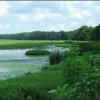 This circular represents a summary of current knowledge on aquatic plants and aquatic plant management strategies, highlighting the Florida situation. The major focus of this circular is the management of aquatic plants as opposed to dealing with nutrients, algae, or water clarity. Included are sections on aquatic plant biology, aquatic plant management problems, and aquatic plant management techniques. This 43-page guide was written by Florida LAKEWATCH; reviewed by Mark Hoyer, and published by the UF Department of Fisheries and Aquatic Sciences, June 2014.
This circular represents a summary of current knowledge on aquatic plants and aquatic plant management strategies, highlighting the Florida situation. The major focus of this circular is the management of aquatic plants as opposed to dealing with nutrients, algae, or water clarity. Included are sections on aquatic plant biology, aquatic plant management problems, and aquatic plant management techniques. This 43-page guide was written by Florida LAKEWATCH; reviewed by Mark Hoyer, and published by the UF Department of Fisheries and Aquatic Sciences, June 2014.
http://edis.ifas.ufl.edu/fa163
Candidate Species for Marine Ornamental Aquaculture: French Grunt, Haemulon flavolineatum
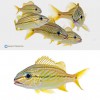 Grunts (family Haemulidae) are some of the most economically and ecologically important fishes found throughout the world. Their common name refers to the characteristic grunting sound they make when they are agitated and during courtship. Many species of grunts are popular in public and private aquariums due to their schooling behavior and bright colors that create interest in aquarium exhibits. The French grunt has recently been identified as a candidate species for aquaculture due to its popularity in aquarium displays and the development of culture protocols. This 4-page fact sheet was written by Kevin P. Barden, Matthew L. Wittenrich, and Eric J. Cassiano, and published by the UF Department of Fisheries and Aquatic Sciences, March 2014.
Grunts (family Haemulidae) are some of the most economically and ecologically important fishes found throughout the world. Their common name refers to the characteristic grunting sound they make when they are agitated and during courtship. Many species of grunts are popular in public and private aquariums due to their schooling behavior and bright colors that create interest in aquarium exhibits. The French grunt has recently been identified as a candidate species for aquaculture due to its popularity in aquarium displays and the development of culture protocols. This 4-page fact sheet was written by Kevin P. Barden, Matthew L. Wittenrich, and Eric J. Cassiano, and published by the UF Department of Fisheries and Aquatic Sciences, March 2014.
http://edis.ifas.ufl.edu/fa186
Cryptobia iubilans in Cichlids
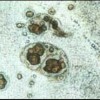 After many years of diagnostics at the University of Florida and at other laboratories around the country, it appears that Cryptobia iubilans is not uncommon among cichlids, and that environmental and other factors determine the extent of disease.This 3-page fact sheet was written by Ruth Francis-Floyd and Roy Yanong, and published by the UF Department of Fisheries and Aquatic Sciences, September 2014.
After many years of diagnostics at the University of Florida and at other laboratories around the country, it appears that Cryptobia iubilans is not uncommon among cichlids, and that environmental and other factors determine the extent of disease.This 3-page fact sheet was written by Ruth Francis-Floyd and Roy Yanong, and published by the UF Department of Fisheries and Aquatic Sciences, September 2014.
http://edis.ifas.ufl.edu/vm077
Koi Herpesvirus Disease (KHVD) (VM149/VM113)
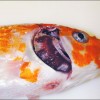 Koi herpesvirus (KHV) is a highly contagious virus that causes significant morbidity and mortality in common carp varieties. Common carp is raised as a foodfish in many countries and has also been selectively bred for the ornamental fish industry where it is known as koi. The first recognized case of KHV occurred in the United Kingdom in 1996. Since then other cases have been confirmed in almost all countries that culture koi and/or common carp with the exception of Australia. This 9-page fact sheet is intended to inform veterinarians, biologists, fish producers and hobbyists about KHV disease. Written by Kathleen H. Hartman, Roy P.E. Yanong, Deborah B. Pouder, B. Denise Petty, Ruth Francis-Floyd, Allen C. Riggs, and Thomas B. Waltzek, and published by the UF Department of Fisheries and Aquatic Sciences, April 2013.
Koi herpesvirus (KHV) is a highly contagious virus that causes significant morbidity and mortality in common carp varieties. Common carp is raised as a foodfish in many countries and has also been selectively bred for the ornamental fish industry where it is known as koi. The first recognized case of KHV occurred in the United Kingdom in 1996. Since then other cases have been confirmed in almost all countries that culture koi and/or common carp with the exception of Australia. This 9-page fact sheet is intended to inform veterinarians, biologists, fish producers and hobbyists about KHV disease. Written by Kathleen H. Hartman, Roy P.E. Yanong, Deborah B. Pouder, B. Denise Petty, Ruth Francis-Floyd, Allen C. Riggs, and Thomas B. Waltzek, and published by the UF Department of Fisheries and Aquatic Sciences, April 2013.
http://edis.ifas.ufl.edu/vm113
Grass Carp: A Fish for Biological Management of Hydrilla and Other Aquatic Weeds in Florida (BUL867/FA043)
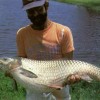 Abundant growth of aquatic plants causes serious problems in ponds, lakes, rivers, and irrigation and drainage throughout Florida. In some situations, native aquatic plants become weeds, but most often exotic plants introduced from areas outside the state flourish under the favorable growing conditions found in Florida. Long-term economical solutions to Florida’s aquatic weed problems have been elusive and there is a need for control techniques to alleviate aquatic weed problems. This 6-page fact sheet provides information on a biological method, the grass carp, for management of some of Florida’s aquatic weed problems. Written by David L. Sutton and Vernon V. Vandiver, Jr., and published by the UF Department of Fisheries and Aquatic Sciences, November 2013.
Abundant growth of aquatic plants causes serious problems in ponds, lakes, rivers, and irrigation and drainage throughout Florida. In some situations, native aquatic plants become weeds, but most often exotic plants introduced from areas outside the state flourish under the favorable growing conditions found in Florida. Long-term economical solutions to Florida’s aquatic weed problems have been elusive and there is a need for control techniques to alleviate aquatic weed problems. This 6-page fact sheet provides information on a biological method, the grass carp, for management of some of Florida’s aquatic weed problems. Written by David L. Sutton and Vernon V. Vandiver, Jr., and published by the UF Department of Fisheries and Aquatic Sciences, November 2013.
http://edis.ifas.ufl.edu/fa043
Lernaea (Anchorworm) Infestations in Fish (FA185)
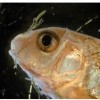 Lernaea species, commonly known as “anchorworms,” are crustacean, copepod parasites that can infect and cause disease and mortality in many types of freshwater fishes, especially wild-caught and pond-raised species. Infestations with Lernaea are most prevalent in the summer months and occur more commonly in stagnant or slow-moving water bodies. This 4-page fact sheet was written by Natalie Steckler and Roy P. E. Yanong, and published by the UF Department of Fisheries and Aquatic Sciences, December 2012.
Lernaea species, commonly known as “anchorworms,” are crustacean, copepod parasites that can infect and cause disease and mortality in many types of freshwater fishes, especially wild-caught and pond-raised species. Infestations with Lernaea are most prevalent in the summer months and occur more commonly in stagnant or slow-moving water bodies. This 4-page fact sheet was written by Natalie Steckler and Roy P. E. Yanong, and published by the UF Department of Fisheries and Aquatic Sciences, December 2012.
http://edis.ifas.ufl.edu/fa185
Argulus (Fish Louse) Infections in Fish (FA184)
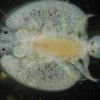 Argulus species (Family: Argulidae), more commonly known as fish lice, are members of a large group of branchiuran parasites that infest and cause disease in fish. The argulids are crustaceans and are related to crabs, lobsters, and shrimp. This 5-page fact sheet was written by Natalie Steckler and Roy P. E. Yanong, and published by the UF Department of Fisheries and Aquatic Sciences, November 2013.
Argulus species (Family: Argulidae), more commonly known as fish lice, are members of a large group of branchiuran parasites that infest and cause disease in fish. The argulids are crustaceans and are related to crabs, lobsters, and shrimp. This 5-page fact sheet was written by Natalie Steckler and Roy P. E. Yanong, and published by the UF Department of Fisheries and Aquatic Sciences, November 2013.
http://edis.ifas.ufl.edu/fa184
Sturgeon Aquaculture: Specialized Techniques: Determining the Sex of Sturgeon by Direct Examination of the Gonad Using a Minimally Invasive Surgical Procedure (FA183)
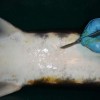 Because male sturgeon are harvested for meat at 2-4 years of age and females are retained for caviar production, being able to determine the sex of individual sturgeon has specific economical advantages. But it is difficult to tell females from males, especially when the fish are young (from hatch to 3 years old). This 5-page fact sheet describes the standard method and tools for determining the sex of sturgeon by direct examination of the gonad using a minimally invasive surgical procedure. Written by Frank A. Chapman and Joel P. Van Eenennaam, and published by the UF Department of Fisheries and Aquatic Sciences, November 2012.
Because male sturgeon are harvested for meat at 2-4 years of age and females are retained for caviar production, being able to determine the sex of individual sturgeon has specific economical advantages. But it is difficult to tell females from males, especially when the fish are young (from hatch to 3 years old). This 5-page fact sheet describes the standard method and tools for determining the sex of sturgeon by direct examination of the gonad using a minimally invasive surgical procedure. Written by Frank A. Chapman and Joel P. Van Eenennaam, and published by the UF Department of Fisheries and Aquatic Sciences, November 2012.
http://edis.ifas.ufl.edu/fa183
Spring Viremia of Carp (VM142/VM106)
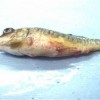 Spring viremia of carp is a viral disease that can cause significant mortality in several carp species including the common carp. It was reported in koi and feral carp in the United States for the first time in 2002. Diagnosis in farm raised fish in the U.S. may result in quarantine of the infected fish and depopulation. This 5-page fact sheet is intended to inform veterinarians, biologists, culturists, and hobbyists about Spring viremia of carp. Written by Barbara D. Petty, Ruth Francis-Floyd, and Roy P.E. Yanong, and published by the UF Department of Fisheries and Aquatic Sciences, August 2012.
Spring viremia of carp is a viral disease that can cause significant mortality in several carp species including the common carp. It was reported in koi and feral carp in the United States for the first time in 2002. Diagnosis in farm raised fish in the U.S. may result in quarantine of the infected fish and depopulation. This 5-page fact sheet is intended to inform veterinarians, biologists, culturists, and hobbyists about Spring viremia of carp. Written by Barbara D. Petty, Ruth Francis-Floyd, and Roy P.E. Yanong, and published by the UF Department of Fisheries and Aquatic Sciences, August 2012.
http://edis.ifas.ufl.edu/vm106
Common Monogenean Parasites of Fishes (FA28/FA033)
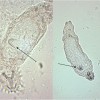 Monogeneans are a class of parasitic flatworms that are commonly found on fishes and lower aquatic invertebrates. Most monogeneans are browsers that move about freely on the fish’s body surface feeding on mucus and epithelial cells of the skin and gills; however, a few adult monogeneans will remain permanently attached to a single site on the host. Some monogenean species invade the rectal cavity, ureter, body cavity, and even the blood vascular system. Between 4,000 and 5,000 species of monogeneans have been described. They are found on fishes in fresh and salt water and in a wide range of water temperatures. This 10-page fact sheet was written by Peggy Reed, Ruth Francis-Floyd, and RuthEllen Klinger, and published by the UF Department of Fisheries and Aquatic Sciences, June 2012.
Monogeneans are a class of parasitic flatworms that are commonly found on fishes and lower aquatic invertebrates. Most monogeneans are browsers that move about freely on the fish’s body surface feeding on mucus and epithelial cells of the skin and gills; however, a few adult monogeneans will remain permanently attached to a single site on the host. Some monogenean species invade the rectal cavity, ureter, body cavity, and even the blood vascular system. Between 4,000 and 5,000 species of monogeneans have been described. They are found on fishes in fresh and salt water and in a wide range of water temperatures. This 10-page fact sheet was written by Peggy Reed, Ruth Francis-Floyd, and RuthEllen Klinger, and published by the UF Department of Fisheries and Aquatic Sciences, June 2012.
http://edis.ifas.ufl.edu/fa033
Megalocytivirus Infections in Fish, with Emphasis on Ornamental Species (FA182)
Megalocytiviruses cause systemic infections that can result in moderate to heavy losses in many different species of freshwater and marine fishes in both cultured and wild stocks. This 8-page fact sheet was written by Roy P. E. Yanong and Thomas B. Waltzek, and published by the UF Department of Fisheries and Aquatic Sciences, December 2010.
http://edis.ifas.ufl.edu/fa182
Lymphocystis Disease in Fish (FA181/FA181)
Lymphocystis is a chronic disease of freshwater and marine fishes caused by infection with an iridovirus known as Lymphocystivirus or Lymphocystis disease virus (LCDV). Infection results in the development of pebble or wart-like nodules most commonly seen on the fins, skin, or gills, although other tissues may be affected. This 5-page fact sheet was written by Roy P. E. Yanong, and published by the UF Department of Fisheries and Aquatic Sciences, December 2010.
http://edis.ifas.ufl.edu/fa181
Viral Nervous Necrosis (Betanodavirus) Infections in Fish (FA180/FA180)
The betanodaviruses are an important, emerging group of viruses known to infect over 40 marine fish species worldwide. This 7-page fact sheet was written by Roy P. E. Yanong, and published by the UF Department of Fisheries and Aquatic Sciences, December 2010.
http://edis.ifas.ufl.edu/fa180
Sharks for the Aquarium and Considerations for Their Selection (FA179)
Sharks are magnificent animals and an exciting group of fishes. And they are becoming increasingly popular as pet animals. The proper care and display of sharks requires great attention to details. This 8-page fact sheet provides critical points aquarists must consider in deciding whether or not to include sharks in their aquaria. A table of the most popular sharks kept in public and home aquariums is provided to facilitate species selection. Written by Alexis L. Morris, Elisa J. Livengood, and Frank A. Chapman, and published by the UF Department of School of Forest Resources and Conservation Program in Fisheries and Aquatic Sciences, December 2010.
http://edis.ifas.ufl.edu/fa179
FA178/FA178 Perkinsus Infections of Bivalve Molluscs
FA178, a 7-page fact sheet by Denise Petty, describes the infections caused by this group of protistan parasites that can infect shellfish — signs of infection in molluscs, life cycle, transmission, diagnosis, regulatory concerns, treatment and disinfection of facilities, and food safety. Includes references and glossary. Published by the UF Department of School of Forest Resources and Conservation, August 2010.
http://edis.ifas.ufl.edu/fa178
